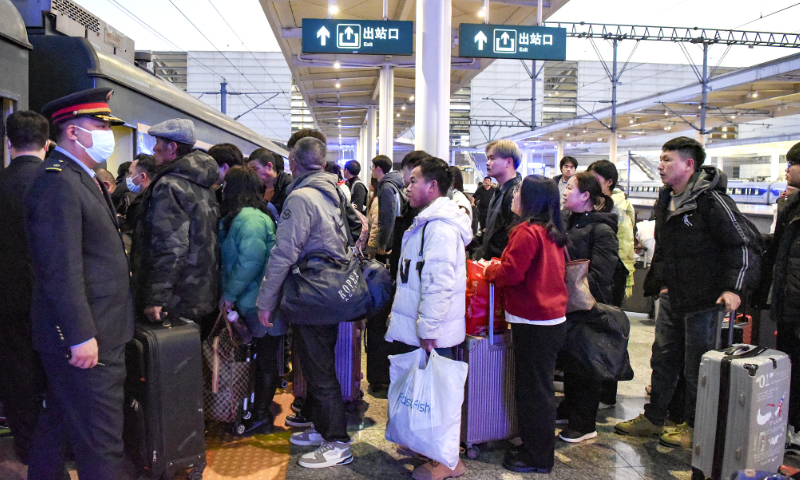Spring Festival travel rush expected to surpass pre-pandemic levels, reach new highs

Passengers are queuing to board a train at Hangzhou South Railway Station on January 17, 2024. Photo: VCG
During this year's Chunyun or Spring Festival travel rush, the scale of mobility in China is expected to significantly surpass pre-pandemic levels, with railway and civil aviation passenger volumes poised to reach record highs, officials said on Friday at a televised conference. Chunyun is the world's largest human migration activity, and is expected to run from January 26 to March 5 this year, totaling 40 days.
To address the challenge, officials at the conference said it is essential to strengthen guidance for staggered travel among students, migrant workers and tourists, and to avoid peak travel times as much as possible.
During peak hours and in high-traffic areas, the passenger and vehicle flow is significant, the officials noted. They said tasks such as organizing transportation capacity, providing transport services, guiding staggered travel, and organizing emergency response should be effectively implemented.
Relevant departments will be required to increase transport capacity, strengthen connectivity among road, air and rail lines, and prioritize the transportation of essential goods.
China's capital Beijing released a Chunyun passenger volume prediction on Friday, noting that during the 40 days of travel rush, Beijing anticipates significant growth in intercity and intra-city traffic compared to the same period last year.
According to the forecast, the total volume of railway, civil aviation, and inter-provincial passenger transport in and out of Beijing is projected to reach 49.88 million trips, showing a 55 percent increase from 2023 and a 12 percent increase from 2019.
Family reunion remains the main purpose of the passenger flow, as Spring Festival is the biggest event for Chinese people and most will choose to spend the holiday with their families.
Beijing expects a relatively stable passenger flow before the holidays but a concentrated pattern afterwards.
As this year's Spring Festival holidays are one day longer than usual, the peak passenger flow might see some reduction, with staggered travel becoming a new trend. It is estimated that the peak daily passenger flow during the Spring Festival travel rush in Beijing will not exceed that observed during last year's Labor Day and National Day "golden week" holidays.
Shanghai also released a forecast for Chunyun on Friday, expecting the total volume of passenger traffic for arrivals and departures to reach 42.37 million trips, representing a year-on-year rise of 49 percent, but a 5 percent decrease compared to the same period in 2019.
South China's Guangdong Province, the most populous province in China with a considerable number of immigrants, said the estimated passenger throughput for the entire province during the Spring Festival travel rush will be approximately 127 million trips, a year-on-year increase of 24.8 percent compared to 2023.
Guangdong authorities expect a strong recovery in people's willingness of travel, with personalized modes of transportation such as private cars, ride-hailing services, and intercity carpooling becoming increasingly common.
As with Beijing, Guangdong also predicted that the overlapping intensity of Spring Festival travel passenger flows will be relatively low, as many enterprises have an early pre-holiday break in most provinces, allowing travelers to leave early.
Taking into account the growing enthusiasm for Hong Kong-Guangdong exchanges, Guangdong authorities said the Hong Kong-Zhuhai-Macao Bridge shuttle bus is scheduled to operate approximately 1,300 round trips between the SAR and Guangdong per day during Chunyun.
Global Times
